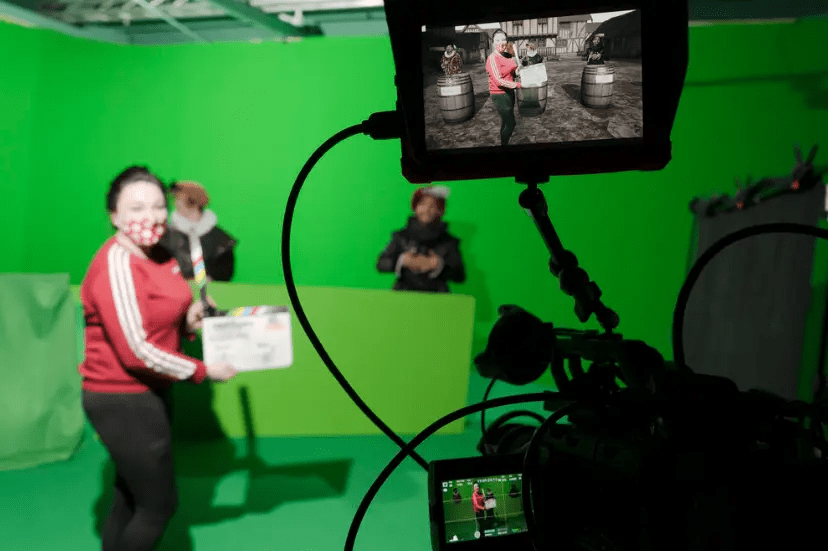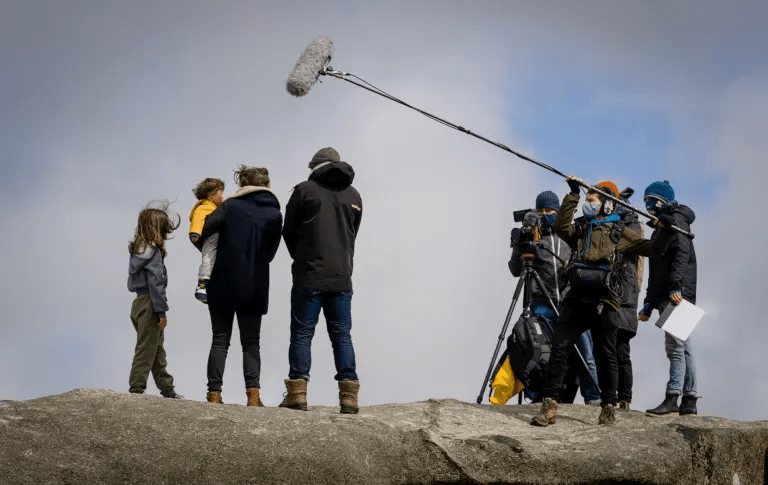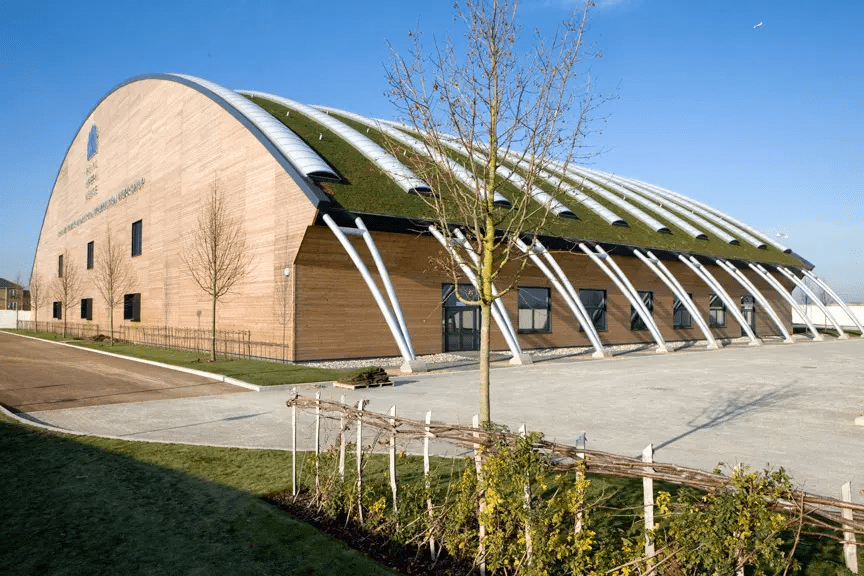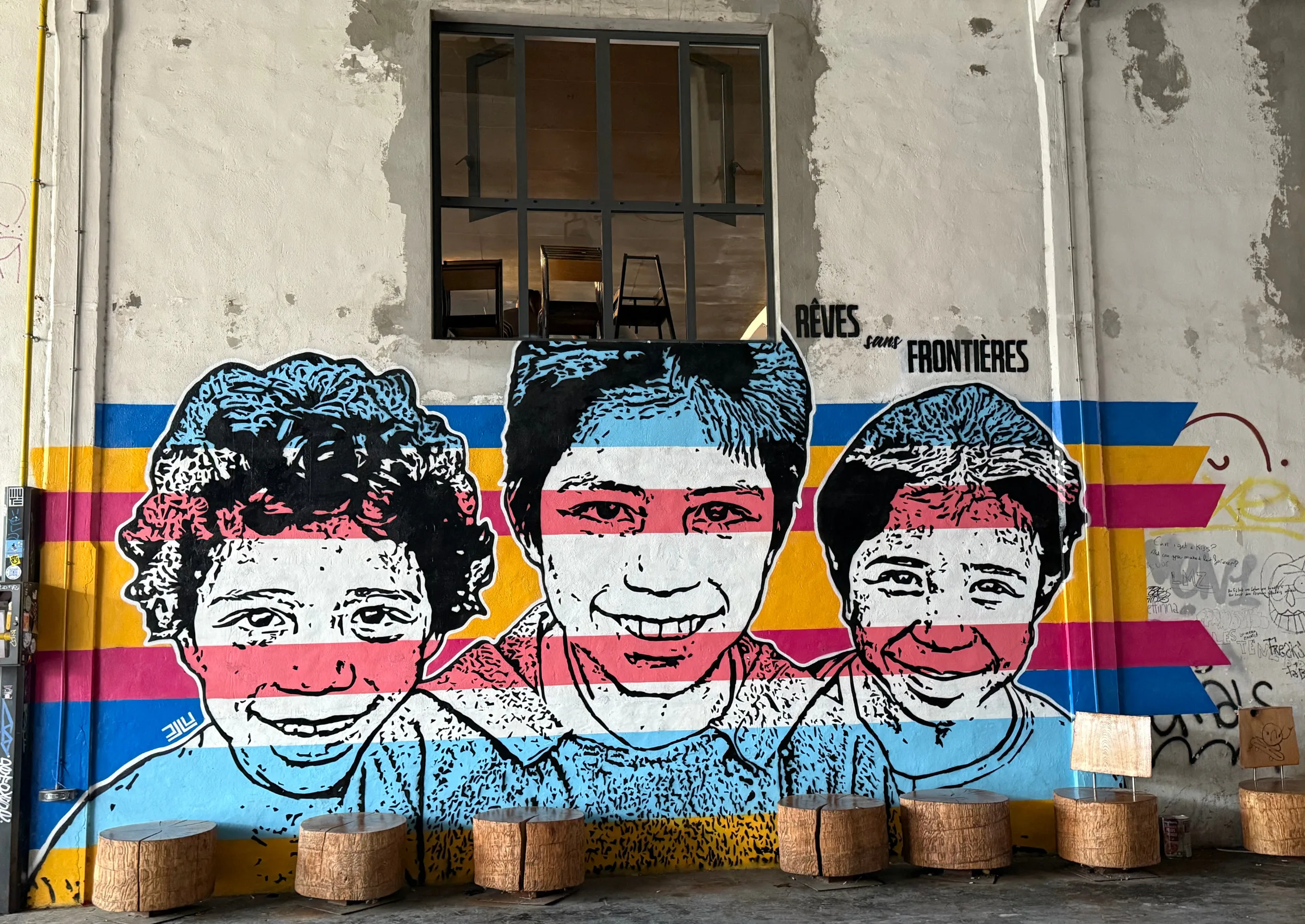Creative Clusters – Case Studies
The creative clusters in these case studies share some common factors that can lead to success. For example, the role performed by ‘anchor institutions’ (often universities or large venues, museums or galleries) in local places, the importance of building on local heritage and skills while also innovating and looking to the future of the industry, the centrality of networks that bring together those with different skills, and the need to understand the strengths within a locality that could represent valuable areas for growth.
________________________________
Hero image credit: Alex Holyoake on Unsplash
Pioneering Places East Kent
Pioneering Places brought together leading cultural organisations, creative practitioners, artists and multiple local authorities across four sites in East Kent. This partnership of creative microclusters across Canterbury, Dover, Folkestone and Ramsgate brought out the benefits of collaboration and cooperation between these neighbouring towns and cities whilst also giving each its own focus, drawing on the individual strengths of the local creative and cultural communities.
Folkestone is one of three coastal towns involved in the Pioneering Places partnership. As lead partner, Creative Folkestone built on its own record of success in developing a cultural district that has built up a local creative ecosystem over the past twenty years. This includes Folkestone’s Creative Quarter – an urban village of designers, filmmakers, musicians, web designers, artists, makers and retailers, housed in more than 90 restored buildings, 80 flats, 115 studios and offices and over 50 shops.
While many coastal towns will often focus regeneration strategies on rebuilding the visitor economy, Creative Folkestone’s CEO, Alastair Upton, is clear that its success has been based on a strategy of seeing how creative activity can make the town a better place in which to live, work, play, study “and, really last in the list, a better place for people to visit”. Speaking at the Creative Coalition Festival, Alastair explains this is based on a different model of creative, cultural and arts-based regeneration:
“We’re all familiar with the model of regeneration through the arts, which is often done through a new building. It’s a consumption model because you’re regenerating in part through the old industry of tourism or people visiting.”
“Folkestone took a very different approach of a production based regeneration model. The Creative Quarter was built through an initial purchase of 90 buildings in a very run-down part of town which were done up, converted and only used for creative purposes. So we now have a community of 600 creative people living and working on a daily basis in the Creative Quarter, ranging from architects, artists’ studios, designers, to small charities working with people with significant disabilities supported through creative practice in their working lives”.
Led primarily by leading local cultural organisations within the East Kent cluster, each of the four Pioneering Places projects had a similar focus on how creative and cultural activity can empower communities to have real and lasting impact on the very fabric of their towns and cities. Specifically, this was achieved through regeneration of different heritage sites that had somehow lost their function or were otherwise forgotten, derelict or overlooked.
Pioneering Places delivered clear benefits to local authority partners and to communities, including:
- more than 29,000 community participants, reporting a measurable boost in sense of civic pride;
- more than 140 local partners, stakeholders, creative SMEs community groups involved in delivery;
- 1,500 schoolchildren participating across 30 local schools
- previously disused or forgotten heritage sites unlocked with an estimated development value in excess of £39m.
Core funding for the partnership project was through Arts Council England and National Lottery Heritage Fund’s Great Place Scheme, with additional support through Kent County Council, Thanet District Council, Canterbury Christ Church University, Historic England and Artswork . The Pioneering Places partnership’s success in connecting communities to local planning through arts, creative industries and heritage was further recognised at a Levelling Up Through Culture event at the Palace of Westminster and by the Royal Town Planning Institute (RTPI) with a nomination for a prestigious RTPI Planning Award.
Watch the full Creative Coalition panel, Multiple Towns, Maximum Impact, including the Creative Folkestone case study
InGame, Dundee
Dundee is considered the home of Scottish gaming; It has a significant number of homegrown start-ups and high-growth enterprises including 4J Studios, Outplay Entertainment, Ninja Kiwi Europe, Rockstar, Tag Games and Unity. It is also the birthplace of some of the best-selling international titles; Grand Theft Auto, Lemmings and the console version of Minecraft. Dundee City Council is a longstanding supporter of the sector, investing in digital infrastructure and economic partnerships that deliver an advantage to local SMEs.
InGAME is the region’s £11.5 million research and innovation cluster, established following an investment from the Creative Industries Clusters Programme (CICP). It aims to increase the scale and value of Dundee’s cluster, by de-risking innovation, supporting scale-up capacity, and addressing national sector challenges. It is led by Abertay University, in partnership with the University of St Andrews and the University of Dundee. This consortium collaborates with industry partners (including Beano Studios/DC Thomson, BBC, Microsoft, Nesta, Outplay, Roblox) to deliver research and innovation across design, technology, and business modelling.
InGame offers funding and support that responds to the needs of the Dundee cluster. For example, InGame partnered with Creative UK to sponsor up to six Scottish companies taking part in the Accelerate: Games Programme, a BFI-funded Creative Enterprise initiative, with three priority spaces for the Dundee Videogame Cluster. Another offer is the Collaborative R&D Vouchers scheme, providing professionals and businesses with an opportunity to access research expertise, equipment, and talent to validate an innovative idea, such as Game Dr’s game Remedy Quest.
InGame also offers businesses the opportunity to access new markets. Competitions have been created to encourage collaboration between the video games industry and wellbeing and sustainability sectors such as health, education, and sectors linked to the net zero mission. For example, the Nesta Virtual Health Neighbourhood Challenge looks at the potential of technologies such as AI, big data, and digital twins to better understand and solve societal challenges. InGame Director Sean Taylor says “..emerging technology trends and societal innovations will transform the way we live, work and play in the next decade. Investing in developing local advanced digital technologies capabilities will leave regions better placed to overcome emerging societal challenges and capitalise on growth opportunities.”
InGame is strengthening Dundee’s presence on the national stage by working with organisations to address sector wide challenges, in particular the need to diversify the work force and gamer experience. For example, InGame worked with Women in Games to address the gender imbalance, and with Open Inclusion and XR Access to improve games in terms of accessibility. InGame is also working in partnership with other CICP commissioned clusters such as StoryFutures on the challenge Inclusive Design or Immersive Experiences and Creative Informatics for MetaMap.
The innovation cluster has leveraged £7.5m co-investment, funded 150 collaborative R&D projects, upskilled 1,500 professionals from industry and academia, established a 36-month research collaboration with Shanghai partners, and undertaken research on behalf of the Department of Culture Media and Sports (DCMS). InGame is a core reason for Dundee’s success in becoming a5G Innovation hub. Acknowledging the success of InGame, Gordon Brown’s Our Scottish Future think tank has recommended the innovation cluster be recognised as a“strategic national asset”.
CDF Network – Plymouth
Ten years after publication of its first Culture Strategy, Plymouth’s creative and cultural sector now accounts for nearly £70m of economic output per year and has secured more than £50m investment in the sector by outside funders in the last five years alone. This success has led to a renewal of the Plymouth Culture Plan for 2021-2030, which aims to develop a diverse and resilient creative and cultural sector to position it as “the driving force or economic and social prosperity in Plymouth.”
As one of the five first round Cultural Development Fund (CDF) projects which form the pilot CDF Network, Plymouth secured £3.5m from DCMS, with a further £2.5m from funding partners, to deliver an ambitious programme of activity focused on delivering and supporting:
- Creative leadership
- Startup and innovation programmes
- Immersive technologies – including the first immersive dome in Europe
- Digital fabrication at FabLab Plymouth
- Smart Citizens programme
- Large scale creative and cultural events programme, including the city-wide Illuminate Festival, Ignite Festival and The Hatchling
Although support and activities are focused on the creative industries, connecting the creative sector with local communities, with each other and with other sectors has been a key factor. Speaking at the Creative Coalition Festival, Hannah Harris, CEO of Plymouth Culture, explains:
“In all of the cases, one of our core priorities was thinking about a connection to non-creative sectors. A lot of the projects are about creative and cultural leadership, but the programmes have included people beyond the creative industries – including healthcare and the marine sector, which is hugely important for Plymouth. It’s been a fantastic programme for us to understand and advocate for the value of culture across all the city areas and the city sectors.”
As the first UK city to join the Fab City Network, with a commitment for the city to produce nearly everything it consumes by 2054, Plymouth is also eager to connect communities with wider sustainability agendas through its creative sector and the Smart Citizens programme. This helps citizens develop skills to design and make their own objects, products and artwork using digital fabrication through the FabLab and in partnership with Arts University Plymouth. Hannah adds:
“A lot of what we’re describing around technology and immersive experiences is also about how people engage with those things, how they can take those skills and those technologies and apply them to their real world challenges and real world lives. The Smart Citizens programme, working out of the FabLab, has engaged thousands of local citizens in new technologies around fabrication and manufacture”.
Crucial to the success of the programme – and common amongst all the other successful first round CDF Network projects in Creative Estuary, Grimsby,Wakefield and Worcester – is the partnerships built around the programme design and delivery, working closely and collaboratively with the local authority. In Plymouth, core partners included Plymouth City Council, Arts University Plymouth, Plymouth Culture, Real Ideas Organisation, University of Plymouth, Creative UK and Crowdfunder.
Watch the full CDF Network panel, How can culture engineer the levelling-up agenda
The Cardiff City Region Screen Industries – Clwstwr

Cardiff, after Greater London and Manchester, has the third largest film and TV cluster in the UK. The Region is home to noteworthy UK broadcasters such as BBC, major studios such as Wolf Studios, and established independent production companies such as Vox Pictures, Avanti and post-production house Gorilla. The sector was firmly established in the 1980’s to produce content for regional broadcasters BBC Cymru Wales and S4C. The quality of content and talent in the region led to substantial growth with UK-wide and international productions such as Sky’s Discovery of Witches, Lucasfilm’s Willow series, the Netflix global hit series Sex Education, and BBC’s Doctor Who now produced within the region.
An analysis looking at the region’s economic growth through audio visual activities found over 1,300 active businesses in the Cardiff City Region media sector, generating an estimated total annual turnover of £545m, supporting 4,950 full-time employees alongside an estimated 2800 freelancers. One in eight new TV, film production and post-production jobs in the UK is created in the Cardiff City Region. It is anticipated the Cardiff City Region will continue to see considerable growth with the recent establishment of its new BBC Wales headquarters in Cardiff, commitment by Channel 4 and BBC network to expand commissioning within the region, and the Sony Pictures Television acquisition deal with Bad Wolf.
Clwstwr is the region’s research and innovation cluster funded by the Creative Industries Clusters Programme with significant contribution from strategic partners, including the Welsh Government. The success of Clwstwr is clearly demonstrated by an additional £50m investment to establish a new innovation programme Media.Cymru, led by Cardiff University, which will respond to opportunities within emerging technologies, while addressing growth barriers within the region. This strategic investment programme brings together 24 media production, broadcast, technology, university, and local leadership partners for the first time to supercharge media innovation.
Professor Justin Lewis, Director of Clwstwr, said: “The creative industries are an important part of the UK’s economy: so, for example, around one in eight businesses in Cardiff are creative enterprises. They also enrich our towns and cities, enhancing communities and people’s quality of life.
“Cardiff Council’s understanding of the economic, social, and cultural importance of the creative sector has meant they have been supportive partners in Clwstwr – and other initiatives like Creative Cardiff – from the outset. They are aware that the creative industries bring employment, enhance tourism, create a sense of vibrancy, increase community cohesion and local identity: in the 21s tcentury they are a vital part of both local economic strategy and place-based social and cultural policy”.
In addition, Cardiff University’s highly respected School of Journalism, Media and Culture is located in a purpose-built facility adjacent to the new BBC Cymru/Wales building, with students benefiting from being part of this networked vibrant media quarter.
Creative Kernow

Creative Kernow, is one of Cornwall’s most prominent creative industry organisations and an Arts Council England, National Portfolio Organisation. Its mission is: ‘To enrich and energise creative communities through the production, distribution and promotion of artistic work, networks and knowledge’. It was founded in 1983 as the Cornwall Arts Centre Trust, by a group of arts activists looking to campaign on local issues and promote performing arts in Truro and Falmouth. It has grown into a cornerstone of the region’s creative sector with specialisms in media, culture-led placemaking and network development, contributing to both regional and national strategy development.
Cornwall has a largely rural population with a lack of connecting infrastructure and a major decline in core industries, including fishing and mining, which has had a long term impact on employment and economy. Cornish wages are 25% less than the national average. Creative Kernow measures its success in terms of ensuring Cornwall has a diverse cultural offer, enabling communities to find a creative solution to issues like the climate crisis and mental health and contributing to the growth of the creative industries. Creative Kernow works closely with Cornwall Council which has a manifesto for Cornwall to be the leading rural creative economy in the UK.
Its current programme covers three core areas: Cultural Engagement, Creative Economy Support and Creative Hub Development via Krowji, the largest creative hub in Cornwall, with over 120 studio spaces. Krowji welcomes all those involved in the creative industries from businesses to individual artists. Meeting rooms are available for hire, the onsite café provides free WiFi, and there is free parking. Studio tenants benefit from being part of the cluster via support, contacts and funding opportunities from other Creative Kernow programmes such as Cultivator, Open Studios and Screen Cornwall.
Creative Kernow has a diverse funding portfolio with the majority of income coming from European Structural Funds (set to be replaced by the UK’s Shared Prosperity Fund’). In addition they receive support from Cornwall Council, Arts Council England (via their NPO status) and through earned income. In 2021/22 the organisation generated £267,724 in earned income and an additional £350,000 from rent and other property income.
Thames Estuary Production Corridor

“ Our vision for the world’s largest creative production corridor is bold. It will position London and the South East as a world leader for the creative industries on a scale never seen before, creating a landmark corridor along the Estuary, powering skills opportunities and new jobs. ” – Sadiq Khan, Mayor of London.
Creative and cultural production activities are already worth £3.7bn to the Thames Estuary economy, with more than 16,000 businesses supporting over 46,000 jobs. The sector has grown by over a third in recent years, outstripping national averages and exceeding the previous rate of growth across the Estuary economy.
The Estuary is a critical breeding ground for new creative and cultural production, with emergent cultural districts fostering the development of new work – in film, gaming, design and the performing and visual arts.
This momentum and identified growth potential are factors behind the vision for the Thames Estuary Production Corridor, which aims to unite east London, the North Kent Coast and South Essex to create a world-class centre for creative and cultural production. By 2050 the Production Corridor is projected to generate more than 50,000 jobs – creating the UK’s largest concentration of production activity and adding an extra £3.1bn to the UK economy.
Emma Wilcox, Project Director, Creative Estuary said:
“Working across local government boundaries on a shared regional vision has been critical to our success and impact. Our work through Creative Estuary has demonstrated how an ambitious vision and strategic, place-based intervention, intended to make a long-term difference to the cultural and creative life of a community and its economic fortunes, can create a step change.”
The Estuary has already seen large-scale cultural development, including Turner Contemporary in Margate and High House Production Park, home to the Royal Opera House’s Production workshop and costume centre. New developments at the Royal Docks and East Bank, are seeing the V&A (in partnership with the Smithsonian Institution), Sadler’s Wells, the BBC, University College of London and UAL’s London College of Fashion, all opening new facilities.
The Thames Estuary Production Corridor initiative was highlighted as a high priority by the Thames Estuary 2050 Growth Commission in its June 2018 report to Government. In January 2019 the Creative Estuary project was awarded £4.3m from DCMS, through the Cultural Development Fund to unlock long-term, transformational, culture-led growth and establish the region as a world-class creative hub, delivering across three main areas of activity from Southend to Margate:
- Cultural programme and new commissions
- Placemaking, new cultural infrastructure and new Planning policy
- Skills, training and leadership programmes, with new models and routes into employment in the creative industries.
The Creative Estuary programme is delivered by consortium led by the University of Kent and including the South East Local Enterprise Partnership, Kent and Essex County Councils, 11 local authorities represented by the Greater North Kent and Opportunity South Essex, Locate in Kent, South East Creative Economy Network (SECEN), the GLA, University of Essex, and cultural organisations Metal and Cement Fields.
See this PEC research paper for more on learning from the Thames Estuary Production Corridor experience.
Production Park Ltd

Production Park is a Yorkshire based family-owned SME founded in 1991 specialising in production, technology and education for the live events industry. It has grown to become the largest cluster of live events businesses in Europe.
In 2005, Production Park built Europe’s first arena rehearsal studio in South Kirkby, Wakefield, now home to a thriving community of live events businesses and freelancers, with up to 700 people on site during busy production periods.
Alongside the studios, Production Park has established a number of world-leading facilities including; workshops, tech labs and teaching facilities. Production Park is instrumental in supporting the production and artist rehearsal of the world’s leading shows, festivals, digital and structural art, and sporting spectaculars.
Past and present clients include Frank Stella and Zaha Hadid, Beyonce, Coldplay, Kasabian and The Killers, as well as Glastonbury, Wireless and Leeds and Reading Festivals. Underpinning this, is the Higher Education (HE) subsidiary Backstage Academy, the leading provider of specialist HE courses to the sector, attaining both growing student numbers and a roadmap towards independence with taught degree awarding powers.
The skills of those working on the Park include; automation & robotics, advanced engineering and manufacturing, software and control systems, immersive technology & content, scenic art and design as well as catering services and personal chefs – all supported by finance, marketing and project management teams. These roles have comparatively high salaries and offer graduate employee opportunities (rare in the area) as well as providing employment for local residents.
In 2019 the world-leading, live technology company TAIT, with headquarters in the US employing over 1000 staff worldwide, invested in acquiring a facility on Production Park making it the largest European production site. The addition of TAIT has expanded the markets served by Production Park to include theme parks, film and TV and large scale installations.
Recent investments by XPLOR, the research arm of Backstage, have seen new TV and film clients using the facilities, as technologies from live events are increasingly used in virtual production replacing green screen, representing a further area for growth.
Lee Brooks, Managing Director says: “What tends to be underestimated are the range of career options available in the creative sector and the varied markets we serve. The artists on the stage or the screen are the focal point of an enormous and complex operation with a huge range of demand for varied expertise and careers.”
The next phase of development is aimed at meeting clients’ continued demand for more project and studio rehearsal space, generating employment opportunities both on the park and with supply chain companies and for dedicated academic space for the expansion of Backstage Academy.
XR Stories

XR Stories, a £15m partnership between the University of York, Screen Yorkshire and the British Film Institute, funded by AHRC, set out to establish Yorkshire and Humber as the UK’s centre of excellence for immersive and interactive storytelling.
Since 2018 XR Stories has provided a focal point for a creative cluster of 600+ screen industry companies and leveraged R&D capacity in our regional universities through a programme of funded collaborations.
Impact to date:
- 80+ Collaborative Projects: Supporting regional SMEs in immersive storytelling R&D.
- 3 Lead Customer Challenge Projects: Technology driven storytelling with international clients and UK creative sector SMEs working together through R&D innovation sprints.
- 6 Research Fellows: Growing XR Stories’ core research base.
- 16 MSc/MA by Research/PhD Studentships: Delivered in partnership with industry.
- 15 StoryLab Participants: Supporting emerging screen-based storytelling talent.
- Regional Internship Programme: 59 people matched with 34 creative organisations.
- £1m in new R&D space to support business focused immersive storytelling and skills.
- £5.9m investment from UKRI, leveraging Co-Investment totaling £20.8m.
In 2022, XR Stories secured a city centre base in the historic York Guildhall Complex, as part of a strategic partnership between the City of York Council and the University of York. XR Stories occupies the top floor with a dedicated R&D Lab and offices, also supported through ERDF funding via the Dept. for Levelling Up, Housing & Communities. XR Stories is working with the city to promote inward investment opportunities to international companies.
In January 2022 XR Stories led a successful £3.3m bid to EPSRC for XR Network+ Virtual Production in the Digital Economy, a project that responds to the emergence of Virtual Production as an area of significant growth. This programme bridges five Creative Cluster projects (Business of Fashion, Textiles and Technology, FutureScreens Northern Ireland, Creative Informatics, Clwstwr) and connects the four UK nations.
XR Stories commissioned BOP Consulting to evaluate the Potential of the Creative and Digital Economies within the region and the Impact of XR Stories. It was noted that: “Some of the fastest growing companies in the Screen Industries in Yorkshire and Humber have worked with XR Stories. As the UK seeks to move beyond Covid-19 and benefit from a recovery of international visitors, XR [technologies] can showcase Yorkshire and Humber and improve the quality of visitor experiences in the region. XR Stories should be woven into the growth strategies of all sectors with potential to bring jobs and growth to Yorkshire and Humber through research and development with XR [technologies] ”.
Stream GM, Greater Manchester

This case study is from ‘Culture in Crisis: Impacts of Covid-19 on the UK cultural sector and where we go from here‘, Centre for Cultural Value.
In April 2020, the Greater Manchester Combined Authority (GMCA) launched United We Stream GM, a digital cultural and fundraising initiative that streamed live performances of DJs, spoken word artists, classical concerts and theatre throughout the national, regional and local lockdowns of 2020–2021.
United We Stream GM hosted 48 live streams over nine months. These received a combined total of 20 million views and raised £583,000 for creative, cultural and night-time businesses as well as charities (StreamGM Sponsorship Release). This was made possible through the tireless work and the generosity of cultural practitioners, record labels and venue owners, often offering services at low or no cost. This, combined with the positioning of United We Stream GM as a fundraising initiative to engage with audiences during a period marked by an immense outpouring of solidarity and charity, enabled the platform to raise over five times as much funding as it cost to develop it.
The GMCA Culture team are now working to transform this ad hoc fundraising initiative into a long-term, sustainable programme of digital culture with a clear place-based identity, creating the community interest company StreamGM.
StreamGM’s core aims are to support and promote Greater Manchester talent, to connect global audiences with the best of Greater Manchester, to lead and participate in global conversations, and be an ethical and sustainable business. Further testing of the model has begun, and StreamGM’s first show, the FLOW talent showcase, took place on 22 April 2021.
Since FLOW, StreamGM has produced and hosted five events, including The Untold Orchestra Presents Four Women and Homoelectric at the Manchester International Festival, the UN Convention 2021, a 12-hour set from DJ Graeme Park, and Greater Manchester (Digital) Pride. As a local government initiative in partnership with senior figures in the city-region’s creative and night-time economy, the outcome of this new venture, which takes a strong place-brand as the basis for connecting with global audiences digitally, will be one to watch.
Highlands and Islands Enterprise
Highland and Islands Enterprise (HIE) operates across eight distinct regions. HIE has long recognised the value of the creative sector to the regional economy. Initially much of the focus was on the role of culture in building community capacity but since 2001 HIE has also had a dedicated Creative Industries focus, at the commercial end of the spectrum.
Iain Hamilton, Head of Creative Industries, Highlands and Islands Enterprise says:
“The creative economy is built on how communities, businesses and individuals can turn cultural knowledge into economic returns. While much of the sectoral research has focussed on urban areas, rural areas and businesses, with their own distinct stories, culture of innovation, sense of place and provenance, can be argued to have as much if not more to offer global consumers. As the importance of digital and the ability to more directly engage with consumers grows, rural creative businesses offer skills and knowledge essential to all other sectors.”
HIE offers a range of sector agnostic support, from account management and investment, to innovation support, infrastructure support (e.g. broadband), international trade, graduate placements and leadership training.
HIE operates via dispersed teams and so is able to provide clients with the most appropriate advice to them and with a creative industry specialism where relevant. The benefits of having extremely distributed teams are speed and flexibility, and the ability to access talent and move quickly as the need arises, while carrying relatively low overheads.
XpoNorth is the mechanism used by HIE to provide specialist support to the Creative Industries. It aims to grow the sector, encourage innovation and address critical gaps. A particular issue facing the creative sector in the region is scale and fragmentation with 72% of creative businesses in the region employing fewer than five people. However HIE doesn’t consider this a barrier to growth and provides tailored support so that employment and GVA gains can be achieved even by very small businesses.
The four core services XpoNorth provides are;
- XpoNorth: Year-round advisory service and annual international creative industries business conference. Advice, training, innovation support, networking, business opportunities.International advisory network.
- XpoNorth Digital: Part of Northern Innovation Hub and covering Highland Council area. Focus on adoption of digital tools, crowd economy and deeper engagement with customer base.
- XpoNorth Heritage: Bringing together heritage and wider creative industries to develop new ways of working, digital uptake and new revenue opportunities.
- LevelUp: Partnership with the University of the Highlands and Islands to address skills gaps identified for the region, support students to be more work ready, greater links between industry and academia, create new networks.
A recent evaluation of XpoNorth found that;
“The model allows HIE to reach further into the creative industries than would otherwise be possible, and through the provision of industry-specific support, delivered by people with deep knowledge of the sectors and its markets, the model is delivering strong impact and excellent value for money. The conference merits specific mention as findings show it has consistently grown in strength and profile and is now attracting leading industry players to the region to the benefit of the sector and is encouraging interaction between different business sectors.”
Between 2019 – 2022 XpoNorth worked with 6,740 businesses and in 2021 it provided intensive, in-depth support to 83 students, as well as delivering 820 workshops.
The Leeds City Region – Textile Innovation Cluster
The UK has a world-famous and influential fashion sector, employing nearly one million people and contributing £32bn to the nation’s economy.
Leeds City Region is a key geographical cluster in the UK’s fashion industry, a sector employing nearly one million people nationally, and a major exporter of high value products. An estimated 10,000 people are employed by the region’s textile design and manufacturing companies, supplying internationally renowned and prestigious brands such as Chanel, Prada, Burberry, Erdem and Paul Smith. Fabric produced in the region is exported across the world, with some companies exporting over 90% of their creative output. Generations of textile knowledge and skills is unique to the region. Traditional skills are still used today across the textile mills of the region, producing bespoke and hand-crafted items for contemporary fashion, but as well as being steeped in tradition the region is also forward-looking, vibrant and innovative.
The Future Fashion Factory (FFF) is the region’s fashion and textile research and innovation cluster, established in 2018 following funding from the Creative Industries Clusters Programme. FFF works within an extended partnership, which includes the Leeds City Region LEP (LCR LEP), Leeds City Council (LCC), Huddersfield Textile Centre of Excellence (TCoE), West Yorkshire Consortium of Colleges (WYCC), the RCA, University of Huddersfield and UK-wide sectoral bodies UK Fashion & Textile Association (UKFT) and the British Fashion Council (BFC). Since its formation FFF has been helping the fashion and textile industry increase its agility & responsiveness to market demand, using new digital and textile technologies to quickly respond to the needs of the luxury fashion design process and shift towards a circular economy. FFF Programmes cover five core research themes that are aligned to industry needs and underpin the FFF membership, engagement activities, and networks. Based in Yorkshire the cluster has developed a membership network which spans the breadth of the UK & covers all aspects of the Fashion & Textile supply chain.
The FFF industry network consists of >520 micros, SMEs and PLCs that represent the whole fashion and textile design supply chain, from design of raw materials through to finished garments and end-of-life management. Recognising the research and innovation needs of the region, FFF designed a place-based R&D funding mechanism that was inclusive and agile, able to respond to the bespoke requirements of successful applicants and encouraging collaborative activity both within the region and across the UK. The support available spans the needs of business at different stages of the innovation journey, from proof-of-concept to scale-up and translation. In addition to research and collaborations through its ‘Responsive R&D’ open call funding, FFF is adding value by reviewing, focusing and sign-posting company innovation ideas, channelling them into the most appropriate funding calls, including other sources of alternative investment. A programme of bespoke engagement & event activity sits alongside FFF’s innovation programme, to stimulate activity and disseminate outcomes throughout the sector.
The Future Fashion Factory has become the partner of choice for industry-led innovation and R&D project development within the sector. To date it has evaluated >300 innovation ideas, awarded 55 R&D project grants, generated 9 new businesses, and leveraged >£33m in aligned public and private-sector match. It has also forged a national and international network that ensures impact across the sector and beyond the region. Such has been FFF’s success and profile within the Leeds City Region, that the University of Leeds has launched a new cross-cutting multi-disciplinary organisation called theLeeds Institute of Colour and Textiles, a £21.1m industry and academic investment focusing on the science and technology for material, methods and processes innovation for a sustainable Colour, Textile and Fashion industry.
Related Blogs
What UK Job Postings Reveal About the Changing Demand for Creativity Skills in the Age of Generative AI
The emergence of AI promises faster economic growth, but also raises concerns about labour market di…
Creative PEC’s digest of the 2025 Autumn Budget
Creative PEC's Policy Unit digests the Government’s 2025 Budget and its impact on the UK’s creative …
Why do freelancers fall through the gaps?
Why are freelancers in the Performing Arts consistently overlooked, unseen, and unheard?
Insights from the Labour Party Conference 2025
Creative PEC Policy Adviser Emily Hopkins attended the Labour Party Conference in September 2025.
Association of South-East Asian Nations’ long-term view of the creative economy
John Newbigin examines the ASEAN approach to sustainability and the creative economy.
Take our Audience Survey
Take our quick survey and you might win a National Art Pass.
Culture, community resilience and climate change: becoming custodians of our planet
Reflecting on the relationship between climate change, cultural expressions and island states.
Cultural Industries at the Crossroads of Tourism and Development in the Maldives
Eduardo Saravia explores the significant opportunities – and risks – of relying on tourism.
When Data Hurts: What the Arts Can Learn from the BLS Firing
Douglas Noonan and Joanna Woronkowicz discuss the dangers of dismissing or discarding data that does…
Rewriting the Logic: Designing Responsible AI for the Creative Sector
As AI reshapes how culture is made and shared, Ve Dewey asks: Who gets to create? Whose voices are e…
Reflections from Creative Industries 2025: The Road to Sustainability
How can the creative industries drive meaningful environmental sustainability?
Creating value: the creative economy beyond culture by Marta Foresti
Marta Foresti explains the value of international cooperation as she becomes Chair of the GCEC.












